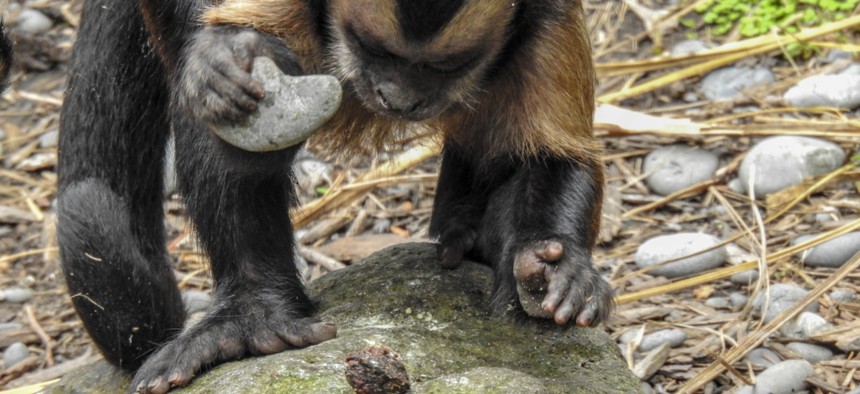Monkeys Stick with Stuff that Isn't Working Too

Lisa Crawford/Shutterstock.com
In humans, this is called the “sunk costs” phenomenon.
Capuchin monkeys and rhesus macaques have the same reluctance to give up on something they’ve already committed time and effort to as humans, researchers report.
The researchers also say it occurs more often when the monkeys are uncertain about the outcome.
In humans, this is called the “sunk costs” phenomenon, where the more resources we sink into an endeavor, the likelier we are to continue—even if we sense it’s futile.
But why would we engage in such potentially self-defeating behavior?
The researchers think two factors may play a role. First, it may be a deep, evolutionarily ancient mechanism that helps us balance overall cost and benefit. Second, it may be influenced by uncertainty about the outcome (you never know, it might work out, so why not keep trying?)
The new study appears in Scientific Reports.
The monkeys from the study live at the Georgia State University’s Language Research Center, where they have indoor and outdoor areas to live and play in, and participate in entirely voluntary and non-invasive cognitive and behavioral research, says Sarah F. Brosnan, a professor affiliated with the psychology department and the Center for Behavioral Neuroscience. In fact, she has worked with some of these monkeys for over twenty years. “They’re like my second set of kids,” she says.
In the study, 26 capuchin monkeys and 7 rhesus macaques got to play a simple video game where they operated a joystick, and they needed to move a cursor onto a moving target and keep it there while the target kept moving. If they were successful, they heard a “whoop” sound that indicated success and got a treat. If their cursor lost contact with the moving target, they didn’t get a reward and a new round began. After being trained, the experiment tested them on rounds of either 1, 3, or 7 seconds.
“Monkeys have really quick reaction times on these games,” says Brosnan, “so one second to them is actually a long time.”
In fact, “Most rounds lasted only 1 second,” says Julia Watzek, a recent Georgia State University PhD recipient. “So if you didn’t get a reward after that, it was actually better to quit and start a new round. That would likely get you a treat sooner than if you had kept going.”
The researchers found that both species of monkeys showed sunk cost effects. “They persisted 5 to 7 times longer than was optimal,” says Brosnan, “and the longer they had already tried, the more likely they were to complete the entire task.”
Uncertainty played a large part, because when the monkeys got a signal that additional work was required, they were less susceptible to sunk cost behavior, though they still did demonstrate it.
Studying this phenomenon in animals “teaches us something about how their minds work, as well as our own,” Watzek says.
This is important for several reasons, Brosnan says. First, it suggests that this behavior is likely driven by evolution and deeply embedded across species.
“The epitome of the sunk cost is ‘I’ve invested so much in this, I’m just going to keep going,'” Brosnan says. And there may be benefits to this. “Sometimes, you need to have patience,” she says. That helps when you’re foraging for food, hunting prey, waiting for eggs to hatch, seeking a mate, or building a nest or enclosure.
Second, it shows that human capacities like rationalization, or human concerns like not giving up on something we have publicly committed to, are probably not the main drivers of the sunk cost phenomenon.
And third, it reminds us that there is sometimes a good reason to give up.
“We’re predisposed to keep trying,” Brosnan says. “And when we find ourselves sticking with things, we should also be a little reflective. Do I have a good reason to keep trying? Or should I leave with no reward, because it will save me more in the long run? That’s really hard to do. But hopefully we can use our cognitive abilities to help us overcome the emotional heartache of occasional sunk costs.”
This article was originally published in Futurity. It has been republished under the Attribution 4.0 International license.





